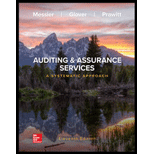
EBK AUDITING & ASSURANCE SERVICES: A SY
11th Edition
ISBN: 9781260687668
Author: Jr
Publisher: MCGRAW-HILL LEARNING SOLN.(CC)
expand_more
expand_more
format_list_bulleted
Concept explainers
Question
Chapter 19, Problem 19.31P
To determine
Concept Introduction:
To describe:The services that P may perform or may not perform.
- The services that may perform: As per the American Institute of certified public accountant code, the CPA should supervise the operation of the new system because the entity requests to set up a new system or covert the prior one into the new system. And the CPA should monitor the source document prepared by entity and also make changes in the IT generated data as the entity asks to involve the implementation of IT information in audit services.
- The services that may not be performed: As per American Institute of certified public accountant code, the services which CPA should not be performing are Counsel on the potential expansion of business activity plans, Search for interview of new personnel, Hiring, and Training personnel as there is no requirement of new personnel.
Expert Solution & Answer
Want to see the full answer?
Check out a sample textbook solution
Students have asked these similar questions
Your firm is contemplating the purchase of a new $610,000 computer-based order entry system. The system will be depreciated
straight-line to zero over its five-year life. It will be worth $66,000 at the end of that time. You will save $240,000 before taxes per year
in order processing costs, and you will be able to reduce working capital by $81,000 (this is a one-time reduction). If the tax rate is 21
percent, what is the IRR for this project?
Note: Do not round intermediate calculations and enter your answer as a percent rounded to 2 decimal places, e.g., 32.16.
IRR
%
QUESTION 1
Examine the information provided below and answer the following question.
(10 MARKS)
The hockey stick model of start-up financing, illustrated by the diagram below, has received a lot of attention in the
entrepreneurial finance literature (Cumming & Johan, 2013; Kaplan & Strömberg, 2014; Gompers & Lerner, 2020). The model
is often used to describe the typical funding and growth trajectory of many startups. The model emphasizes three main
stages, each of which reflects a different phase of growth, risk, and funding expectations.
Entrepreneur, 3 F's
Debt(banks & microfinance)
Research Business angels/Angel Venture funds/Venture capitalists
Merger, Acquisition
Grants
investors
PO
Public market
Growth (revenue)
Break even
point
Pide
1st round
Expansion
2nd round
3rd round
Research
commercial idea
Pre-seed
Initial concept
Seed
Early
Expansion
Financial stage
Late
IPO
Inception and
prototype
Figure 1. The hockey stick model of start-up financing (Lasrado & Lugmayr, 2013)
REQUIRED:…
critically discuss the hockey stick model of a start-up financing. In your response, explain the model and discibe its three main stages, highlighting the key characteristics of each stage in terms of growth, risk, and funding expectations.
Chapter 19 Solutions
EBK AUDITING & ASSURANCE SERVICES: A SY
Ch. 19 - Prob. 19.1RQCh. 19 - Prob. 19.2RQCh. 19 - Prob. 19.3RQCh. 19 - Prob. 19.4RQCh. 19 - Prob. 19.5RQCh. 19 - Prob. 19.6RQCh. 19 - Prob. 19.7RQCh. 19 - Prob. 19.8RQCh. 19 - Prob. 19.9RQCh. 19 - Prob. 19.10RQ
Ch. 19 - Prob. 19.11RQCh. 19 - Prob. 19.12RQCh. 19 - Prob. 19.13RQCh. 19 - Prob. 19.14MCQCh. 19 - Prob. 19.15MCQCh. 19 - Prob. 19.16MCQCh. 19 - Prob. 19.17MCQCh. 19 - Prob. 19.18MCQCh. 19 - Prob. 19.19MCQCh. 19 - Prob. 19.20MCQCh. 19 - Prob. 19.21MCQCh. 19 - Prob. 19.22MCQCh. 19 - Prob. 19.23MCQCh. 19 - Prob. 19.24MCQCh. 19 - Prob. 19.25MCQCh. 19 - Prob. 19.26MCQCh. 19 - Prob. 19.27PCh. 19 - Prob. 19.28PCh. 19 - Prob. 19.29PCh. 19 - Prob. 19.30PCh. 19 - Prob. 19.31P
Knowledge Booster
Learn more about
Need a deep-dive on the concept behind this application? Look no further. Learn more about this topic, finance and related others by exploring similar questions and additional content below.Similar questions
- What is the finance ? tell about its significant.arrow_forwardTake value of 1.01^-36=0.699 . step by steparrow_forwardsolve this question.Pat and Chris have identical interest-bearing bank accounts that pay them $15 interest per year. Pat leaves the $15 in the account each year, while Chris takes the $15 home to a jar and never spends any of it. After five years, who has more money?arrow_forward
arrow_back_ios
SEE MORE QUESTIONS
arrow_forward_ios
Recommended textbooks for you
 Accounting Information SystemsAccountingISBN:9781337619202Author:Hall, James A.Publisher:Cengage Learning,
Accounting Information SystemsAccountingISBN:9781337619202Author:Hall, James A.Publisher:Cengage Learning, Auditing: A Risk Based-Approach (MindTap Course L...AccountingISBN:9781337619455Author:Karla M Johnstone, Audrey A. Gramling, Larry E. RittenbergPublisher:Cengage Learning
Auditing: A Risk Based-Approach (MindTap Course L...AccountingISBN:9781337619455Author:Karla M Johnstone, Audrey A. Gramling, Larry E. RittenbergPublisher:Cengage Learning

Accounting Information Systems
Accounting
ISBN:9781337619202
Author:Hall, James A.
Publisher:Cengage Learning,

Auditing: A Risk Based-Approach (MindTap Course L...
Accounting
ISBN:9781337619455
Author:Karla M Johnstone, Audrey A. Gramling, Larry E. Rittenberg
Publisher:Cengage Learning
Accounting for Derivatives_1.mp4; Author: DVRamanaXIMB;https://www.youtube.com/watch?v=kZky1jIiCN0;License: Standard Youtube License
Depreciation|(Concept and Methods); Author: easyCBSE commerce lectures;https://www.youtube.com/watch?v=w4lScJke6CA;License: Standard YouTube License, CC-BY